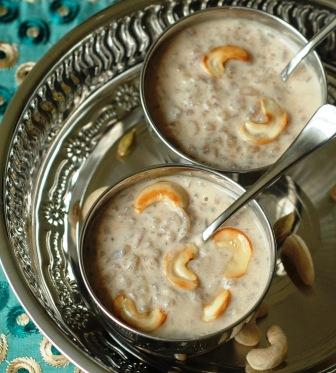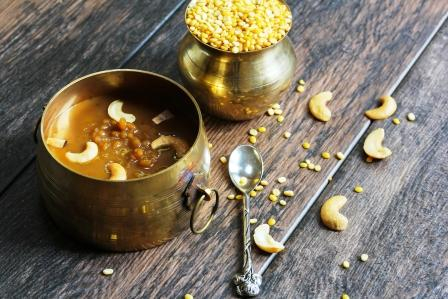
In most Malayali house-holds, whether in their home state of Kerala or elsewhere, no celebration is complete without payasam. Births, anniversaries, festivals and even last rites see it included in menus and for many south Indians, there is simply no better or more befitting treat. Payasam is Kerala’s answer to Italy’s zabaglione, France’s île flottante, South America’s dulce de leche and the Arab world’s Umm Ali. It makes for a splendid ending to a sumptuous meal, is more wet than dry, has to be eaten with a spoon and may involve some surreptitious slurping.
It is widely believed that the term payasam pays homage to peeyusham, which, in some south Indian languages, means nectar or ambrosia. The name also draws from the Sanskrit word payasa for milk, although several versions use coconut milk or cream instead. As the most ubiquitous of Kerala’s sweet offerings, payasam takes centre stage at Onam, when up to four versions can make their way to the ceremonial sadya, or lunch.
White and brown
In a basic identification, colour could make the perfect starting point. Payasams with brown hues — from pale golden to nearly black — feature jaggery or dark palm sugar as the sweetening agent, while the white versions use processed white sugar. Traditionally, sugar is added to milk, or jaggery to coconut milk for the base of the payasam, but the introduction of cream, condensed milk and evaporated milk have seen new variations and inventive recipes that combine two or more liquids and sweeteners. Meanwhile, there are some types that take on the colour of whatever it contains, such as an orange-hued version made with grated carrots.
“As kids, my siblings and I loved only white payasams — the rich creaminess of milk with bits of raisins and nuts, served hot or cold,” Seattle-based cookbook author and blogger Maya Akhil, tells GN Focus. She started her blog, Yummyoyummy.com in 2010 to focus on south Indian classics and fusion dishes. The payasams she has featured include unusual versions made with wheat, mango and rice flakes. “The colour doesn’t matter, but taste most certainly does,” she says.
The lentil route
With the exception of the commonly used vermicelli and the widely grown jackfruit, Kerala’s payasams of yore feature pulses, grain or cereal as the staple ingredient — lentils and wheat or rice, or derivatives such as semolina, sago, broken rice or broken wheat. Regional specialities see sago and bananas cooked in milk, and semolina cooked in coconut milk. A notable exception is the javvarisi payasam, in which sago is cooked with milk or coconut milk, sugar or jaggery and sometimes cream. It can range in colour from white to cream or chocolate brown. An unsung hero is the elaneer payasam, which features water, pulp and slivers of tender coconut cooked in coconut milk. The Masala Bay restaurant in Discovery Gardens serves a delectable version on weekends.
Distinctly devout
Kerala has distinct payasams to mark events and occasions, and the dish also forms part of religious temple ceremonies when it is called prasadam (offering). The aravana payasam, prepared as an offering to Lord Ayyappa at Sabarimala, is among the most famous, but the pal payasam served at the Ambalapuzha Sree Krishna Temple is hailed as the tastiest — although it is the prasadam served at Thrissur’s famed Guruvayoor Temple that stays fresh for weeks.
Many Malayali housewives have adapted another ceremonial food used in Hindu worship called the panchamritam (literally, five nectars) into a payasam, by slow-cooking honey, milk, yoghurt and ghee with bananas, dates or raisins.
“Traditionally, payasam is made in an uruli [circular cookware made of bell metal], but a broad non-stick kadai [often called the Indian wok] would be the best practical alternative in our modern world,” explains Bharathy Vasudevan, author of the food blog Spicy Chilly. “Before preparing the payasam, fill the kadai with water. Boil and discard with a gentle rinse ensuring that any particles of spices stuck to the kadai are fully cleansed.”
Payasams made of mung beans and chickpeas are often cooked in pressure cookers to retain the goodness of the lentils
and shorten cooking time. Many are garnished with fried nuts and raisins and seasoned with powdered cardamom.
Contemporary twist
During Onam, all erstwhile payasam lines get blurred, everything is deemed appropriate, and the most popular appearances are semiya (vermicelli), ari (rice), pal ada (rice flakes) palpayasam (crushed rice), neipayasam (ghee), ada pradhaman (rice flakes), parippu (yellow lentil) and chakka (jackfruit). Local restaurants that host Onasadya usually feature two varieties on the menu, while south Indian restaurant chains such as Appa Kadai and Saravanaa Bhojan Shala offer different types every day of the week at lunch.
For many traditional Malayalis, the payasam stands in for a birthday cake, and Aparna Balasubramanian, who has run the food blog My Diverse Kitchen for eight years, reiterates, “No celebration, however small or big, is complete without payasam. In its simplest form, it is rice cooked in milk and sweetened with sugar, but from there on the sky is the limit when it comes to creativity.”
While payasam is a dessert, it is also served at other times of the day — at tea time, as a snack for guests or as breakfast the next day.
New varieties showcased by enterprising young chefs and avid bloggers make the payasam almost unrecognisable in appearance but just as delicious to taste. The innovative recipes feature unlikely ingredients as stars of the show. “What you need for a perfect payasam is very little time, but a lot of patience,” says Balasubramanian, who once slow-cooked cabbage into a payasam to celebrate her birthday. “Payasams that are thickened slowly are invariably the most flavourful.”













